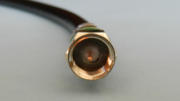Our customers are the best part of Solid Signal. Our customers are a real community, and I think it’s one of the best communities on the web. One of the things I really like about our customers is the number of self-taught experts we get. We get a lot of folks with a general engineering background who have taught themselves about antennas or broadcasting. Those are my folks, the people who really love knowledge. and I love their questions.
Learning more about antennas
I spoke the other day to a retired engineer who had recently bought our SignalScout antenna meter. It’s a great tool for people who need to measure antenna signals all the time because it’s very, very accurate. The measurements it takes, however, are in decibel milliwatts, or dBm. That’s all well and good if you are just trying to keep relative measurement. However, coming from the world of cable television, this fellow was much more comfortable with decibel microvolts, or dBμV.
How can you convert?
First of all, a bit of explanation: dBμV measures voltage, which is independent of the impedance on the line. dBm measures wattage, so you must know the impedance of the line. In most cases the cables you’re using for antennas are 75Ω (75 ohm) so let’s talk about those conversions.
See, using dB (decibels) as a measurement of anything makes conversion very simple because instead of multiplying, you add. That’s the magic of the whole system. So, to convert from dBμV to dBm, subtract precisely 108.75. You’ll most likely get a negative number… that’s ok you expect that. To convert from dBm to dBμV, you add 108.75.
Conversions to other systems are also pretty simple. Just find out what you want to convert and use the appropriate rule below. Note that all of these are for 75 ohm cable.
dBmV = 48.75 + dBm
dBmV = dBµV – 60dBµV = 60 + dBmV
dBµV = 108.75 + dBmdBm = dBµV – 108.75
dBm = dBmV – 48.75
Using one of those rules, you can easily convert between the three standards used for signal levels. It’s simple!
If these are so easily to interchange, why are there three different measurements?
I gotta tell you, I thought the same thing. First of all dBm is much more common when your entire system is using 75 ohm cable. That way you’re not converting back and forth. In systems where you are converting from 50 to 75 ohm, it makes more sense to talk about voltage. Voltage doesn’t change no matter which cable you use, and therefore it’s more useful in those cases.
Some of it is just custom. Maybe one of the first companies to measure a certain thing just did it that way from the beginning, and the practice spread. As with a lot of things, there weren’t always great records kept at the beginning.
Get the equipment you need
If you’re coming to this article without knowing about Solid Signal, you owe it to yourself to get to know us. SolidSignal.com is your home for everything you need to live your best digital life. It doesn’t matter if you’re talking about something small and fun or something really expensive for a commercial installation. You’ll find 50,000 parts at our all new, expanded web site. Check it out now!





